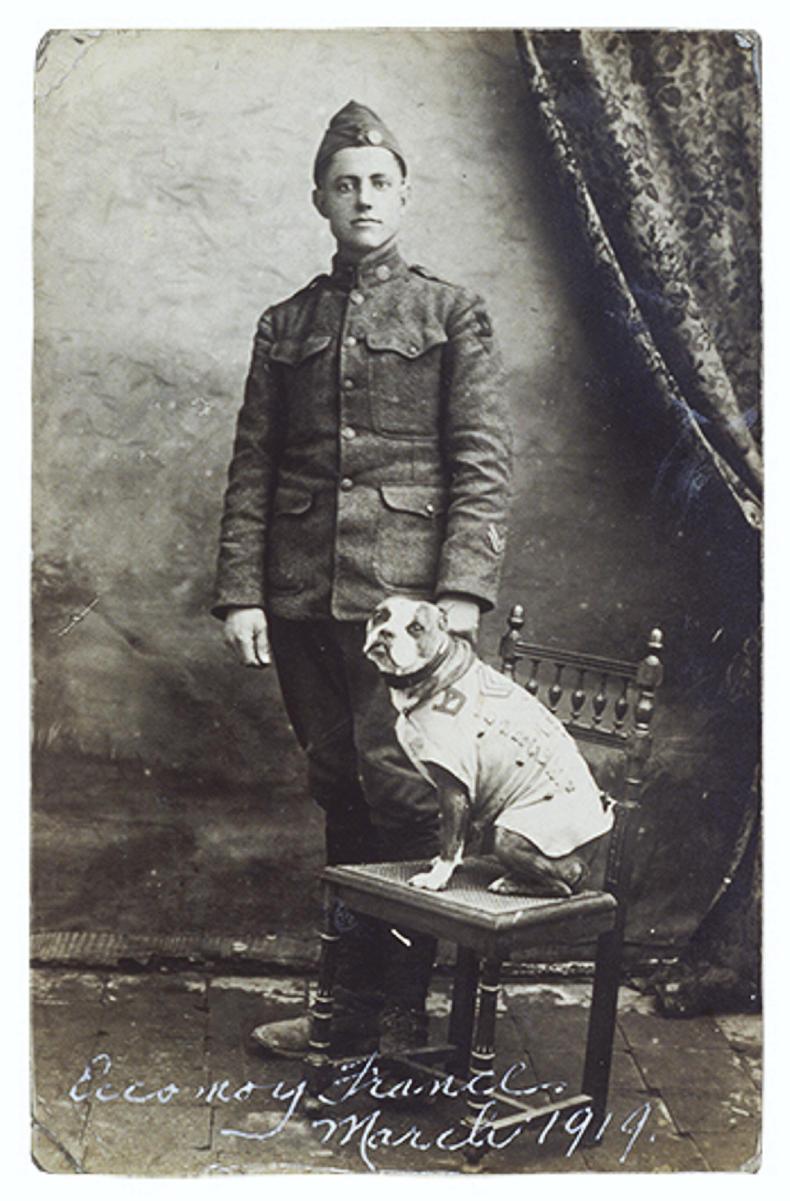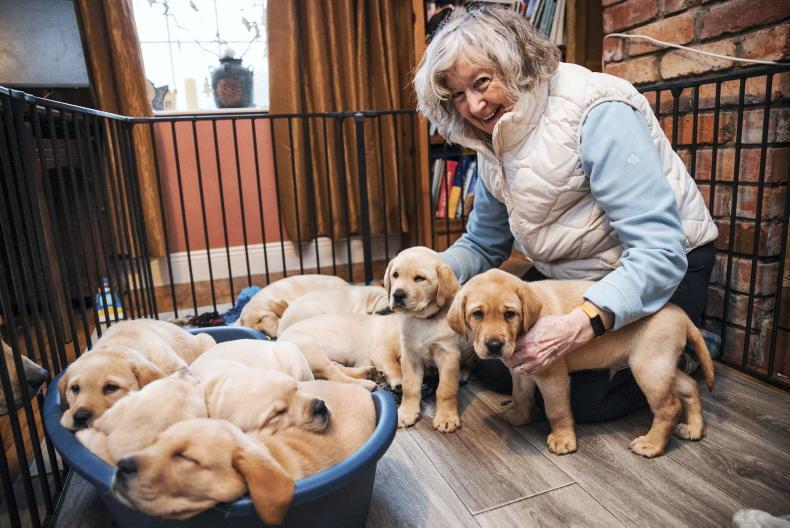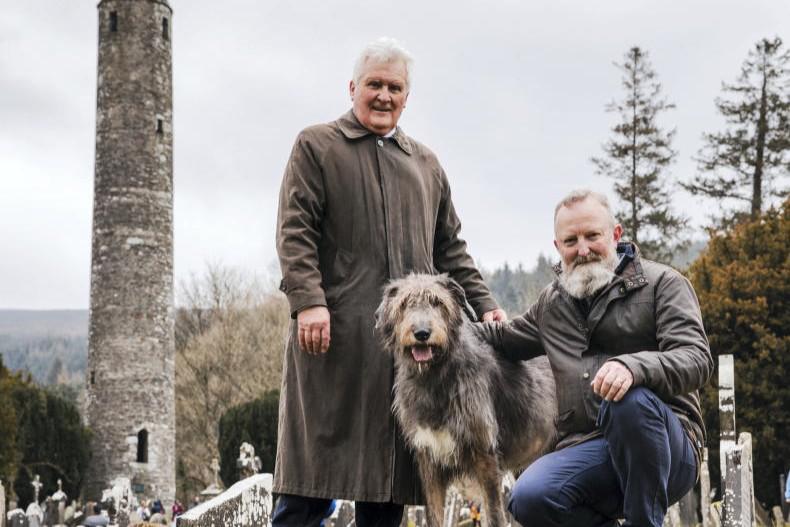During World War I, the exploits of Sergeant Stubby were front-page news of every major American newspaper. The story of this remarkable dog began at Yale University, where young Corporal James Robert Conroy was training for combat. The little stray of six months had a short tail, so Conroy named him Stubby.
While living with the soldiers, clever young Stubby trained as well
Conroy brought Stubby back to camp, and although pets were not allowed, Stubby proved good for the soldiers’ morale and was able to stay. While living with the soldiers, clever young Stubby trained as well. He learned the bugle calls, the drills, and even a modified dog salute as he put his right paw on his right eyebrow when a salute was executed by his fellow soldiers.
Dog to war
When the division shipped out for France, Conroy smuggled Stubby aboard, hidden in the coal bin until the ship was far at sea. On being smuggled off the ship, he was discovered by Corporal Conroy’s commanding officer (CO). Sensing he was in trouble, Stubby gave the CO a salute, which impressed him so much that he allowed Stubby to stay. When the Yankee Division headed for the frontlines in France, Stubby was given special orders allowing him to accompany the division to the front lines as their official mascot. The 102nd Infantry reached the frontlines on 5 February 1918.

When the Yankee Division headed for the front lines in France, Stubby was given special orders allowing him to accompany the division to the front lines as their official mascot.
All too soon, Stubby sustained his first injury. Inhaling toxic gas landed Stubby in the hospital, where he was treated alongside his two-legged comrades. Stubby was nursed back to health and made a full recovery, but the injury left him sensitive to the smell of even the tiniest trace of gas. This came in very useful during a German gas attack, which happened in the morning while most of the soldiers were asleep. When Stubby smelled the offending gas, he ran through the trench barking and biting at the soldiers, rousing them to sound the gas alarm, saving many from injury.
As the German ran, Stubby bit him on the legs, causing the soldier to trip and fall
Stubby also had a talent for locating wounded men between the trenches; he would listen for the sound of English and then go to the location, barking until paramedics arrived or leading the lost soldiers back to the safety of the trenches.
Stubby even caught a German soldier mapping out the layout of the Allied trenches. The soldier called to Stubby, but he put his ears back and began to bark. As the German ran, Stubby bit him on the legs, causing the soldier to trip and fall.

During World War I, the exploits of Sergeant Stubby were front-page news of every major American newspaper.
He continued to attack the man until the American soldiers arrived. For capturing an enemy spy, Stubby was put in for a promotion to the rank of Sergeant by the commander of the 102nd Infantry. He became the first dog to be given rank in the US Armed Forces. Stubby’s promotion put him above the rank of his owner, Corporal Conway.
Reward for bravery
By the end of the war, Stubby had served in 17 battles. His faithful service had saved many lives, and earned him many medals for various deeds. When he landed on American soil, Stubby was an instant celebrity. He led the American troops in a pass and review parade and later visited with President Woodrow Wilson.
His body was donated to the Smithsonian Institute where it was preserved and put on display, along with his 11 medals and decorations
Conroy and Stubby settled down in Georgetown, where Conroy studied law. In 1926, at the age 10, Sgt Stubby passed away. His body was donated to the Smithsonian Institute where it was preserved and put on display, along with his 11 medals and decorations.
If you should ever find yourself in Washington DC, why not accept an invitation from the Smithsonian Institute, at the National Museum of American History, Behring Center, to view this “brave stray”.
Read more
The reign of King Neptune
The brave and loyal old Sea Dog of the Norwegian Navy
During World War I, the exploits of Sergeant Stubby were front-page news of every major American newspaper. The story of this remarkable dog began at Yale University, where young Corporal James Robert Conroy was training for combat. The little stray of six months had a short tail, so Conroy named him Stubby.
While living with the soldiers, clever young Stubby trained as well
Conroy brought Stubby back to camp, and although pets were not allowed, Stubby proved good for the soldiers’ morale and was able to stay. While living with the soldiers, clever young Stubby trained as well. He learned the bugle calls, the drills, and even a modified dog salute as he put his right paw on his right eyebrow when a salute was executed by his fellow soldiers.
Dog to war
When the division shipped out for France, Conroy smuggled Stubby aboard, hidden in the coal bin until the ship was far at sea. On being smuggled off the ship, he was discovered by Corporal Conroy’s commanding officer (CO). Sensing he was in trouble, Stubby gave the CO a salute, which impressed him so much that he allowed Stubby to stay. When the Yankee Division headed for the frontlines in France, Stubby was given special orders allowing him to accompany the division to the front lines as their official mascot. The 102nd Infantry reached the frontlines on 5 February 1918.

When the Yankee Division headed for the front lines in France, Stubby was given special orders allowing him to accompany the division to the front lines as their official mascot.
All too soon, Stubby sustained his first injury. Inhaling toxic gas landed Stubby in the hospital, where he was treated alongside his two-legged comrades. Stubby was nursed back to health and made a full recovery, but the injury left him sensitive to the smell of even the tiniest trace of gas. This came in very useful during a German gas attack, which happened in the morning while most of the soldiers were asleep. When Stubby smelled the offending gas, he ran through the trench barking and biting at the soldiers, rousing them to sound the gas alarm, saving many from injury.
As the German ran, Stubby bit him on the legs, causing the soldier to trip and fall
Stubby also had a talent for locating wounded men between the trenches; he would listen for the sound of English and then go to the location, barking until paramedics arrived or leading the lost soldiers back to the safety of the trenches.
Stubby even caught a German soldier mapping out the layout of the Allied trenches. The soldier called to Stubby, but he put his ears back and began to bark. As the German ran, Stubby bit him on the legs, causing the soldier to trip and fall.

During World War I, the exploits of Sergeant Stubby were front-page news of every major American newspaper.
He continued to attack the man until the American soldiers arrived. For capturing an enemy spy, Stubby was put in for a promotion to the rank of Sergeant by the commander of the 102nd Infantry. He became the first dog to be given rank in the US Armed Forces. Stubby’s promotion put him above the rank of his owner, Corporal Conway.
Reward for bravery
By the end of the war, Stubby had served in 17 battles. His faithful service had saved many lives, and earned him many medals for various deeds. When he landed on American soil, Stubby was an instant celebrity. He led the American troops in a pass and review parade and later visited with President Woodrow Wilson.
His body was donated to the Smithsonian Institute where it was preserved and put on display, along with his 11 medals and decorations
Conroy and Stubby settled down in Georgetown, where Conroy studied law. In 1926, at the age 10, Sgt Stubby passed away. His body was donated to the Smithsonian Institute where it was preserved and put on display, along with his 11 medals and decorations.
If you should ever find yourself in Washington DC, why not accept an invitation from the Smithsonian Institute, at the National Museum of American History, Behring Center, to view this “brave stray”.
Read more
The reign of King Neptune
The brave and loyal old Sea Dog of the Norwegian Navy












SHARING OPTIONS